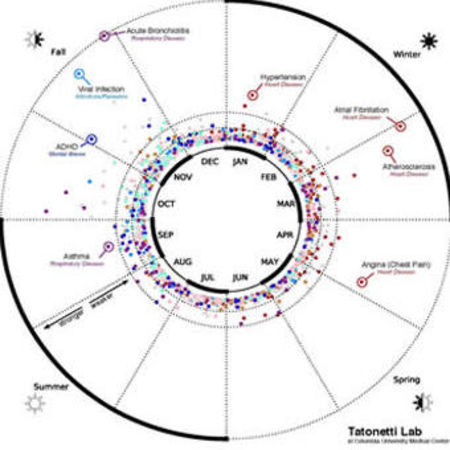Scientists at Columbia University have developed a computational method that investigates the relationship between birth month and disease risk. The algorithm was used to examine New York City medical databases and it found 55 diseases that correlated with the season of birth. The study determined that people born in May are at lowest risk of disease while those born in October are at the highest risk. The study was published in the Journal of American Medical Informatics Association.
"This data could help scientists uncover new disease risk factors," said study senior author Nicholas Tatonetti, PhD, an assistant professor of biomedical informatics at Columbia University Medical Center (CUMC) and Columbia's Data Science Institute. The team plans to replicate this study with data from other locations both in the U.S. and abroad and to determine if the results change with seasons and environmental factors. The researchers are hopeful that disease disparities by birth month may help figure out how the gap could be closed.
The researchers compared 1,688 diseases against the birth dates and medical histories of 1.7 million patients treated at New York-Presbyterian Hospital/CUMC between 1985 and 2013.They were able to rule out more than 1,600 associations and confirmed 39 links previously reported in the medical literature. They also uncovered 16 new associations, including nine types of heart disease. By performing statistical tests, the researchers confirmed that the associations they found did not arise by chance.
"It's important not to get overly nervous about these results because even though we found significant associations the overall disease risk is not that great," notes Dr. Tatonetti. "The risk related to birth month is relatively minor when compared to more influential variables like diet and exercise."
The data obtained from this study is consistent with previous research. The team found that asthma risk is greatest for July and October babies and similar results were observed in a Danish study that found the highest risk from May to August when sunlight levels in Denmark are similar to New York’s July and October. Similarly, this study found ADHD was higher among people born in November and a Swedish study also showed peak rates of ADHD in November babies.
The Columbia University study also found that people born in March faced the highest risk for atrial fibrillation, congestive heart failure and mitral valve disorder and similar results were found in a previous study using Austrian and Danish patient records that people born March through June had higher heart disease rates and shorter life spans.
Source: Columbia University
Image Credit: Dr. Nick Tatonetti



























